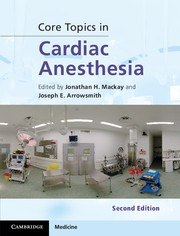39 results
Chapter 28 - Non-Cardiac Applications of Cardiopulmonary Bypass
- from Section 5 - Cardiopulmonary Bypass
-
-
- Book:
- Core Topics in Cardiac Anaesthesia
- Published online:
- 12 May 2020
- Print publication:
- 23 April 2020, pp 215-217
-
- Chapter
- Export citation
Chapter 10 - Mitral Valve Surgery
- from Section 2 - Anaesthesia for Specific Procedures
-
-
- Book:
- Core Topics in Cardiac Anaesthesia
- Published online:
- 12 May 2020
- Print publication:
- 23 April 2020, pp 75-81
-
- Chapter
- Export citation
Chapter 8 - Common Postoperative Complications
- from Section 1 - Routine Cardiac Surgery
-
-
- Book:
- Core Topics in Cardiac Anaesthesia
- Published online:
- 12 May 2020
- Print publication:
- 23 April 2020, pp 55-68
-
- Chapter
- Export citation
25A - Resuscitation after Adult Cardiac Surgery
- from Section 5 - Acute Disorders
-
-
- Book:
- Core Topics in Cardiothoracic Critical Care
- Published online:
- 15 June 2018
- Print publication:
- 05 July 2018, pp 211-219
-
- Chapter
- Export citation
Contributor affiliations
-
-
- Book:
- Textbook of Neural Repair and Rehabilitation
- Published online:
- 05 May 2014
- Print publication:
- 24 April 2014, pp ix-xvi
-
- Chapter
- Export citation
Contributor affiliations
-
-
- Book:
- Textbook of Neural Repair and Rehabilitation
- Published online:
- 05 June 2014
- Print publication:
- 24 April 2014, pp ix-xvi
-
- Chapter
- Export citation
Contributors
-
-
- Book:
- Ecology and Conservation of Estuarine Ecosystems
- Published online:
- 05 April 2013
- Print publication:
- 16 May 2013, pp xiii-xvi
-
- Chapter
- Export citation
Section 5 - Monitoring
-
- Book:
- Core Topics in Cardiac Anesthesia
- Published online:
- 05 April 2012
- Print publication:
- 15 March 2012, pp 133-168
-
- Chapter
- Export citation
Section 7 - Anesthetic management of specific conditions
-
- Book:
- Core Topics in Cardiac Anesthesia
- Published online:
- 05 April 2012
- Print publication:
- 15 March 2012, pp 193-302
-
- Chapter
- Export citation
Section 4 - Cardiac surgery for anesthesiologists
-
- Book:
- Core Topics in Cardiac Anesthesia
- Published online:
- 05 April 2012
- Print publication:
- 15 March 2012, pp 103-132
-
- Chapter
- Export citation
Contributors
-
-
- Book:
- Core Topics in Cardiac Anesthesia
- Published online:
- 05 April 2012
- Print publication:
- 15 March 2012, pp x-xiii
-
- Chapter
- Export citation
Appendix 2: Conversion factors for SI and traditional units
-
- Book:
- Core Topics in Cardiac Anesthesia
- Published online:
- 05 April 2012
- Print publication:
- 15 March 2012, pp 480-480
-
- Chapter
- Export citation
Dedication
-
- Book:
- Core Topics in Cardiac Anesthesia
- Published online:
- 05 April 2012
- Print publication:
- 15 March 2012, pp v-vi
-
- Chapter
- Export citation
Reviews of the first edition
-
- Book:
- Core Topics in Cardiac Anesthesia
- Published online:
- 05 April 2012
- Print publication:
- 15 March 2012, pp xiv-xiv
-
- Chapter
- Export citation
Abbreviations
-
- Book:
- Core Topics in Cardiac Anesthesia
- Published online:
- 05 April 2012
- Print publication:
- 15 March 2012, pp xix-xxvi
-
- Chapter
- Export citation
Section 2 - Cardiac pharmacology
-
- Book:
- Core Topics in Cardiac Anesthesia
- Published online:
- 05 April 2012
- Print publication:
- 15 March 2012, pp 39-74
-
- Chapter
- Export citation

Core Topics in Cardiac Anesthesia
-
- Published online:
- 05 April 2012
- Print publication:
- 15 March 2012
Chapter 74 - Hematological problems
- from Section 11 - Miscellaneous topics
-
-
- Book:
- Core Topics in Cardiac Anesthesia
- Published online:
- 05 April 2012
- Print publication:
- 15 March 2012, pp 465-468
-
- Chapter
- Export citation
Appendix 1: Classification of recommendations
-
- Book:
- Core Topics in Cardiac Anesthesia
- Published online:
- 05 April 2012
- Print publication:
- 15 March 2012, pp 479-479
-
- Chapter
- Export citation
Chapter 30 - Off-pump coronary surgery
- from Section 6 - Routine coronary heart surgery
-
-
- Book:
- Core Topics in Cardiac Anesthesia
- Published online:
- 05 April 2012
- Print publication:
- 15 March 2012, pp 186-192
-
- Chapter
- Export citation



